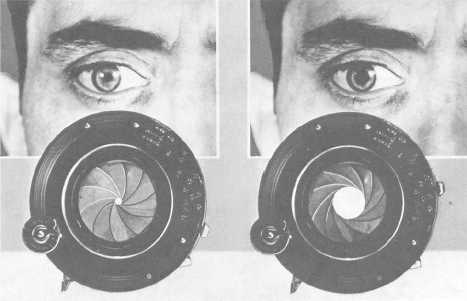Using a long-focal-length lens
Focusing on near objects
APERTURE
The aperture, or f/stop as it is commonly called, is
used to regulate the diameter of the lens opening. That
controls the luminance on the film plane. Besides
controlling the luminance on the film plane, the f/stop
also controls image sharpness by partially correcting
various lens aberrations.
The most commonly used aperture control device is
the iris diaphragm. An iris diaphragm is an adjustable
device that is fitted into the barrel of the lens or shutter
housing. It is called an iris diaphragm because it
resembles the iris in the human eye (fig. 4-12). An iris
diaphragm is a series of thin, curved, metal blades that
overlap each other and is fastened to a ring on the lens
barrel or shutter housing. The size of the aperture is
changed by turning the aperture control ring. The blades
move in unison as the control ring is moved, forming an
aperture of any desired size. The control ring is marked
in a series of f/stops that relate to the iris opening. The
aperture controls the intensity of light that is allowed to
pass to the film and the parts of the image that will
appear in sharp focus.
40.163
Figure 4-12.–Iris diaphragm.
Depth of Field
Depth of field is that zone both in front of and behind
your subject that are in acceptably sharp focus. The
focusing controls on most cameras are easy to use,
providing you understand the factors that effect depth of
field. To produce professional quality photographs, you
must know how to control the depth of field.
Aperture, or f/stop, is the most important factor in
controlling the depth of field. The smaller the f/stop
opening, the greater the depth of field; for example, at
f/16, a normal lens focused on a subject 16 feet from the
camera may show everything in focus from 8 feet to
infinity. At f/5.6, depth of field may range from about 3
feet in front of the subject to about 6 feet behind the
subject. At f/2, only the subject focused on is sharp. As
shown in figure 4-3, a shallow depth of field results in
a blurry foreground and background, whereas greater
depth of field results in more overall sharpness.
Camera-to-subject distance also has an effect on the
depth of field. In general, the closer you are to the
subject, the shallower the depth of field. Even at f/16
with a normal lens, if you focus on a subject only 3 feet
from the camera, the depth of field may only be about 1
foot. At f/2, the subject's eyes may be in sharp focus, but
the nose and ears are blurred. As you increase the
camera-to-subject distance, the depth of field increases
rapidly. Using an aperture of f/16 and focusing at 6 feet,
the depth of field may extend from a foot in front of the
subject to about 3 feet in back of the subject. Still using
4-10


